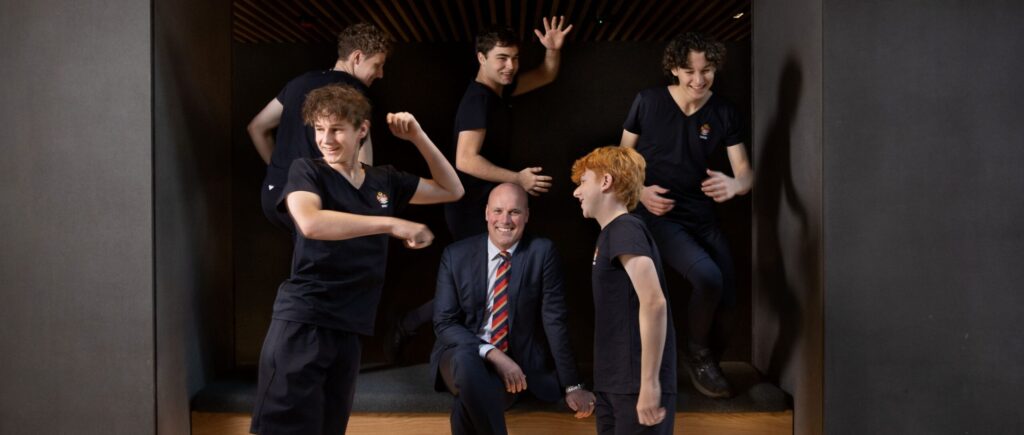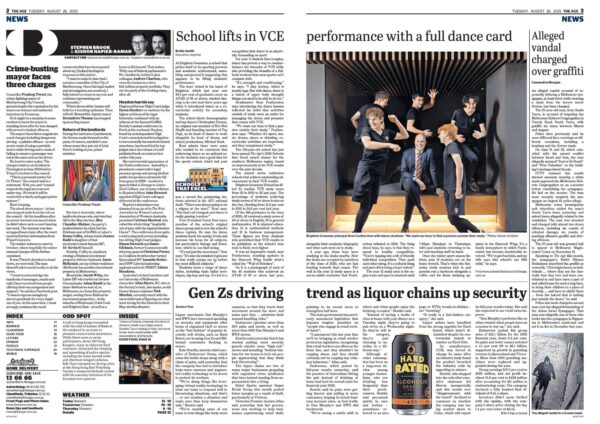School lifts in VCE performance with a full dance card
By Bridie Smith. Photo: Simon SchluterAt Brighton Grammar, a school that prides itself on its sporting prowess and academic achievement, something unexpected is happening that appears to be lifting students’ performance.
The boys’ school in the heart of Brighton, which last year saw 28.5 per cent of graduates score an ATAR of 95 or above, started dancing to its own beat when it introduced dance as a co-curricular activity for secondary students three years ago.
The school hired choreographer and tap dancer Christopher Horsey, an original cast member of Hot Shoe Shuffle and founding member of Tap Dogs, as its head of dance to work alongside the school’s head of drama and school productions, Michael Kent.
Kent admits there were some who needed to be convinced that embracing dance as an optional extra for students was a good idea for the sporty school, which last year saw a record five graduating students selected in the AFL national draft.
“There was always going to be a stigma at the start,” Kent says. “But that’s all changed, and dance is really gaining traction.”
Year 12 student Corey Dow was a member of the school’s original dance group and is now the school’s dance captain.
He says the dance sessions he attends on Mondays and Thursdays boost his energy levels and increase his focus for all subjects, but particularly biology and literature, which he sometimes finds taxing.
“It’s not just the movement,” Dow says. “It’s also the mindset it gets me in that really pumps me up before my most difficult subjects.”
Students learn a range of dance styles, including basic ballet techniques, hip-hop and tap. It’s led to a recognition that dance is as physically demanding as sports such as basketball, football and cricket.
For year 11 student Sam Longley, dance has proven a way to counterbalance the intensity of VCE, while also providing the benefits of a full-body workout that some sports can’t compete with.
“It’s strength and conditioning,” he says. “I play hockey, which is mostly legs. But with dance, there is a bunch of upper body strength things you need to be able to do too.”
Headmaster Ross Featherston says introducing the dance lessons reflected his belief that activities outside of study were an outlet for managing the stress and pressure that comes with VCE.
“We want our boys to find a passion outside their study,” Featherston says. “Whether it’s sport, music, drama, dance or debating, co-curricular activities are important, and they complement study.”
The 143-year-old school has just been named The Age’s 2025 Schools that Excel award winner for the southern Melbourne region, based on improvements in its VCE results over the past decade.
The annual series celebrates schools that achieve outstanding advancement in their VCE results.
Brighton Grammar School has lifted its median VCE study score from 33 in 2015 to 35 last year.
The percentage of students achieving study scores of 40 and above is also on the rise, climbing from 15.8 per cent in 2015 to 24.3 per cent last year.
Of the 286 graduates in the class of 2024, 42 received a study score of 40 or above in English, 25 in general mathematics, 16 in physical education, 15 in mathematical methods and 13 in business management.
These figures are from students who permitted their VCE results to be published, so the school’s true total is likely even higher.
It was an impressive result, says Featherston, standing upstairs in the Hancock Wing beside what’s called the “Wall of Scholars”.
On it is a school photograph of each of the 45 students who achieved an ATAR of 95 and above last year, alongside their academic biography and what each went on to study.
A year ago, these boys were studying at the desks nearby. Now the desks are occupied by members of the Class of 2025, who are fast heading towards final exams.
The wall in the year 12 study space is a not-so-subtle motivator Featherston initiated in 2016, two years after becoming the school’s eighth headmaster.
The thing about boys, he says, is that they respond to healthy competition.
“You’re tapping into a bit of friendly individual competition. They push each other along. It’s a cultural thing and part of it is being a boys’ school,” Featherston says.
The year 12 study area is the engine room and open to students until 7.30pm Mondays to Thursdays, with past students returning to tutor after hours and teaching staff on hand to help.
Once the winter sport season finishes at the end of August, year 12 students are on the home stretch. That’s when the Saturday study sessions kick in and parents run a barbecue alongside a coffee cart for students studying upstairs in the Hancock Wing.
It’s a family atmosphere in which Featherston has become inextricably linked.
“We’ve got four kids, and my wife says this school’s our fifth child.”



